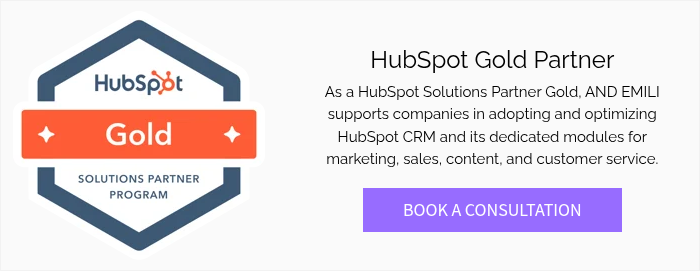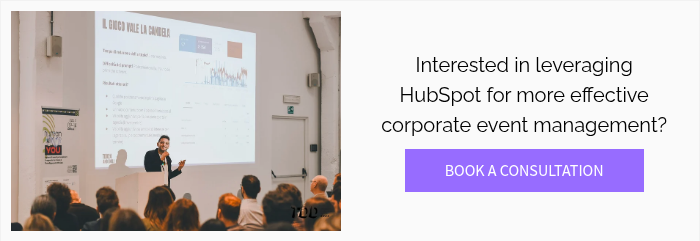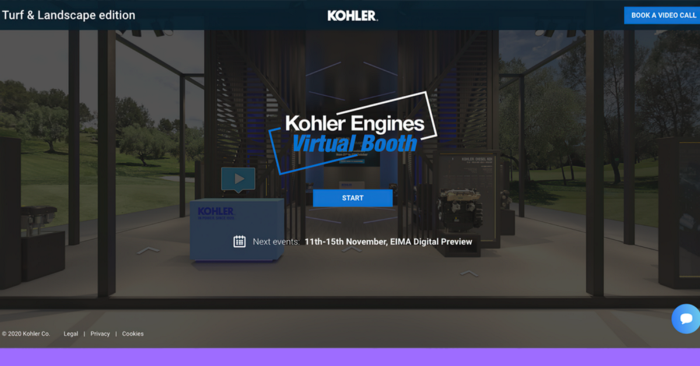Corporate event management: strategic, automated, effective

In recent years, event marketing has taken on an increasingly strategic role for companies aiming not only to generate visibility, but also to create engaging and memorable experiences for their audience. At the same time, technological advancements have transformed how events are planned, promoted, and most importantly, managed, making the use of advanced digital tools essential.
In this context, HubSpot emerges as a multifunctional solution that enables efficient event marketing management, from participant registration to post-event follow-up. With its integrated features for automation, email marketing, CRM, and data analytics, HubSpot empowers marketers to create tailored campaigns, track audience interactions, and optimize event ROI.
Whether it's a webinar, trade show, or in-person event, using HubSpot allows companies to centralize all marketing activities, enhancing coordination across teams and delivering a smooth, engaging experience for attendees. In this article, we will explore the crucial role of technology in event marketing and how HubSpot can be a powerful tool for managing both the organization and the success of corporate events.
Table of Contents:
- Which technological assets are needed to manage corporate events?
- Event planning
- Event management
- Post-event: analysis and follow-up
- Conclusions
1. Which technological assets are needed to manage corporate events?
HubSpot as an all-in-one solution to streamline processes and enhance the user experience
HubSpot is a platform offering a complete suite of tools designed to streamline the management and promotion of corporate events. Thanks to its integrated CRM, collecting and organizing attendee data becomes effortless, allowing marketers to segment audiences and personalize communications based on their interactions. Additionally, its email marketing functionality enables the creation and automation of targeted messages, while tracking their performance in real time. HubSpot also allows for the quick creation of customized landing pages and registration forms, making it easy to collect and use accurate data.
One of HubSpot’s key advantages is the ability to centralize all data within a single platform. This provides marketing teams with a complete overview of performance at every stage, reducing the risk of errors and improving coordination. Its advanced analytics tools make it easy to monitor key metrics such as registration rates, audience engagement, and ROI, helping to improve strategies for future events.
Additionally, HubSpot includes a native “Events” feature, which enables users to manage not only strategic aspects, but also many of the operational elements that are crucial to the success of any event. These include:
By integrating with event management apps or through manual imports, it is possible to track who registers, attends, or cancels their registration.
It also allows for viewing and editing key event details, such as the event description, organizer, event type, and start and end dates.
Events can be linked to specific marketing campaigns, making it possible to monitor how events contribute to the performance of broader campaign efforts.
Process automation
One of the key aspects of event marketing is process automation, especially when it comes to managing communication with participants. Without automation, handling this task would be time-consuming and error-prone. HubSpot’s automation features make it possible to create workflows that send personalized emails based on user actions or language preferences, optimizing every step of the process. This not only saves time, but also enhances the overall experience by ensuring each participant receives the right information at the right moment.
Effective event communication begins right from the invitation. Managing this task manually can be time-consuming and errors-prone, but HubSpot makes the entire process seamless and efficient. From sending personalized invites to triggering automatic confirmation emails upon registration, everything can be automated. Moreover, with customizable forms and landing pages, HubSpot allows registrations to be managed directly within the platform, making it easy to collect data, store it in the contact’s record, and automatically activate the follow-up invitation email.
A customizable platform
HubSpot stands out as an ideal solution for managing corporate events, not only for automating processes but also thanks to its ability to create custom objects tailored to specific needs.
With custom objects, it is possible to structure the CRM including event-specific elements such as participants, sessions, speakers, and more. For instance, an organization managing trade shows could create a custom “Trade Show” object to track schedules, exhibitors, and attendees, enhancing the user experience while simplifying internal operations for the team.
Integrating custom objects into HubSpot’s CRM also helps streamline and automate internal processes, such as sending reminder emails, registering attendees for sessions, and collecting post-event feedback. Thanks to this flexibility, HubSpot offers a complete platform for companies looking to manage corporate events in a personalized and efficient way.
2. Organizing corporate events
Create the event landing page

Event-specific landing pages are essential for capturing audience attention and driving registrations. HubSpot makes it easy to create customized landing pages in just a few clicks or by using ready-made templates, thus simplifying event promotion and boosting conversion rates.
With HubSpot, landing pages not only can be personalized but also tailored to the target audience. This enables a more relevant and engaging experience for each visitor, increasing both engagement and conversions. Here are some effective personalization strategies:
To optimize landing page performance, it is essential to implement a continuous process of testing, monitoring, and improving. HubSpot supports this process by providing tools such as A/B testing for different content, designs, or calls-to-action, making it easier to identify the variations that generate the highest conversion rates.

In addition, real-time analysis of user behavior on landing pages allows content to be continuously adapted based on audience preferences, further increasing overall effectiveness. In this context, HubSpot proves to be a perfect fit by providing the analytics needed to make informed decisions.
Marketing automation
Automation is a key component of event marketing, as it helps simplify and streamline many repetitive tasks, leading to more efficient event management and a better overall experience for participants. As mentioned earlier, HubSpot provides advanced automation tools that enable personalized communication, smoother participant management, and improved internal workflows.
Here are a few practical examples of automations that can optimize the management of corporate events:
Strategic automation enhances operational efficiency and reduces errors, streamlining attendee management, participant communication, and internal organization.
Contact management and segmentation

Advanced segmentation is a powerful feature that allows the audience to be divided into highly targeted groups based on specific variables such as interests, behaviors, and demographic data. In HubSpot, segmentation is managed through the use of lists, which can be either static or dynamic:
Static Lists: groups of contacts or companies added to a list once, without automatic updates. Once a contact is added, it remains in the list even if they no longer meet the original segmentation criteria.
Dynamic Lists: unlike static lists, dynamic lists update automatically based on defined conditions. Contacts are added to the list when they meet the set criteria and removed if they no longer qualify.



These types of advanced segmentation allow for detailed grouping of registrants and participants, making it easier to classify and precisely organize contacts. This level of personalization enables more targeted and relevant communication for each segment, optimizing the overall effectiveness of the marketing strategy.
3. Event management

Integration with event management platform
HubSpot offers seamless integration with various external event platforms such as Eventbrite, Zoom, and GoToWebinar, further simplifying the management of corporate events. These integrations enable automatic synchronization of data between the platforms and HubSpot, centralizing information in one place and streamlining internal processes. Key benefits of integration include:
Integrations make it possible to automatically import event-related data into HubSpot, eliminating the need to manually manage information from multiple sources.

Integrations allow HubSpot to automatically update contact lists and assign tags or scores based on users’ interactions with event management platforms.
Integrations with tools like Eventbrite or Zoom enable automation of key tasks such as registration, sending personalized emails, and organizing participants, thus eliminating repetitive steps and reducing the risk of errors.
Finally, integrations allow for real-time tracking of participation and engagement data. For example, the number of attendees in each online session on Zoom, or the registration rate on Eventbrite. This enables the creation of detailed reports on how events performed.
Integrating HubSpot with external platforms streamlines the overall management of event marketing by automating numerous tasks and enhancing the participant experience through personalized communication. Additionally, synchronizing data across platforms makes it easier to access and enables more in-depth performance analysis.
Data collection during the event

Collecting data during an event is essential for managing and converting potential new leads. This process can take different forms depending on the type of event (online or in-person). The main challenge lies in ensuring data quality once it is transferred into the CRM. Besides the risk of errors or data loss, moving information from the collection point to the CRM can often be time-consuming and complex.
With HubSpot, these processes can be handled simply and efficiently. All data is centralized within the platform allowing it to move smoothly through internal workflows, from the collection point to the CRM, while keeping information organized and clean.
Online data collection: HubSpot handles Q&A forms and chatbots with ease. Here’s a practical example: a company wants to showcase new products and chooses to host an online event to make access easier for clients around the world. HubSpot allows video and live streaming to be embedded directly into landing pages, with the option to place forms below the video, making it easy for participants to ask questions. Alternatively, HubSpot’s chatbot tool can be used for a more advanced and direct interaction. Once the form is submitted or the chatbot conversation is completed, the collected data is automatically synchronized with the relevant records in the CRM.
In-person events: data collection can be done in several ways. For example, a company that regularly attends trade shows may need a fast and simple way to capture prospect information. With HubSpot one option is to use a QR code that potential customers can scan, directing them to a form whose data is automatically synced with the CRM. An even easier solution is to use HubSpot’s mobile app feature to scan business cards and instantly create a new contact in the CRM. This approach makes data collection smooth, natural, and effortless.
4. Post-event: Analysis and follow-up

The success of a corporate event doesn’t depend only on its organization and management, but also on how the post-event phase is managed. Gathering feedback from participants and analyzing event performance are key steps to turning every event into an opportunity for business growth and process improvement.
Collecting feedback through surveys

Gathering participant feedback is essential to evaluate the event’s success, identify areas for improvement, and enhance future editions. HubSpot provides advanced tools to automate feedback collection through customized surveys that can be sent via email, embedded in workflows, or included on landing pages. Each response is linked to the corresponding contact, keeping data clean and centralized within a single platform. There are several ways to collect feedback:
- CSAT (Customer Satisfaction): measures overall satisfaction and is used to gather feedback on any aspect of the customer experience.
- NPS (Net Promoter Score): evaluates the likelihood that participants would recommend the company’s events to others.
- Specific rating: allows for individual questions to evaluate specific aspects of the event, such as organization, content quality, or communication.
The feedback collected can be used to trigger targeted follow-up strategies. For example, based on participant responses, it is possible to tailor post-event communications—sending additional resources, exclusive offers, or invitations to future events. This approach not only enhances the overall experience but also strengthens long-term engagement and loyalty.
Tracking and analyzing event results

The success of an event is not only measured by the number of attendees, but also by the impact it generates and the level of audience engagement. HubSpot goes beyond process automation by offering robust analytics tools that enable real-time monitoring of key metrics and the creation of detailed reports. These reports include essential insights such as registration numbers, participation rates, and email click-through rates. With access to this data, internal teams are fully equipped to assess which strategies had the greatest impact and to identify areas for improvement.
Here are some useful metrics to monitor when managing corporate events with HubSpot:
- Registration Rate: the percentage of users who register for the event out of the total number of invitations sent.
- Attendance Rate: the percentage of actual participants compared to the number of registered attendees.
- Form Conversion Rate: the percentage of users who completed the registration form compared to the total number of form views.
-
Email Open Rate: the percentage of recipients who opened the email.
-
Email Click-Through Rate: the percentage of users who clicked on one or more links or CTAs within the email.
-
ROI (Return on Investment): measures the value generated by the event in relation to the costs incurred.
-
Post-Event Conversion Rate: the percentage of participants who take meaningful actions after the event, such as making a purchase, subscribing to a newsletter, or further engaging with the brand.
Monitoring and understanding data enables strategic decision-making based on concrete insights, maximizing ROI and ensuring continuous improvement from one event to the next. Taking a data-driven approach to event marketing is now essential for maintaining a competitive edge and building long-term relationships with your audience.
5. How to optimize Event Marketing
The success of an event doesn’t depend only on its management, but also on the marketing strategy that supports it. To attract participants, engage them, and build loyalty, effective communication is essential at every stage of the process. HubSpot offers advanced tools to automate and optimize event marketing, helping you reach the right audience with the right message.
Building a strong relationship with your audience is key, turning participants into an active and engaged community. Encouraging experience sharing, collecting feedback, and maintaining ongoing dialogue strengthens the connection with attendees and helps improve future strategies. An effective marketing plan not only increases attendance but also creates a memorable experience that leaves a lasting, positive impact. Using HubSpot for event marketing means working more strategically and efficiently, increasing participation and maximizing return on investment.





